|
November 2016 - February 2017 |
| |
|
|
 |
|
 |
| |
Publisher: Chairman Gong-Ru Lin Editors: Professor
Chao-Hsin Wu, Ms. Hsiao-wen Lin April 15, 2017 |
| |
|
 |
|
Congratulations to GIPO professor I-Chun Cheng on being awarded the “2016 Ta-You Wu Memorial Prize” from the Ministry of Science and Technology, R. O. C.! For more information, please refer to the following website:
https://www.most.gov.tw/most/attachments/82aeeca8-8418-461b-98b2-c5f0c89c1fb8。
Congratulations to Hsin-Ping Wang, GIPO
Ph.D. student, on being awarded, under
the instruction of Professor Gong-Ru Lin, the “2016 Science and Technology Scholarship” from CTCI Foundation!
Congratulations to Tsai-Chen Wu, GIPO master student, on being awarded, under the instruction of Professor Gong-Ru Lin, the “2016 Master Student Thesis Prize” from Taiwan Photonics Society!
Congratulations to Yi-Ting Yao, GIPO master student, on being awarded, under the instruction of Professor Chi-Kuang Sun, the “2016 Japan and Taiwan International Medical Spectroscopy Forum – the best poster prize”!
Congratulations to the following master and doctoral students on being awarded the “OPTIC 2016 Student Paper Award-Oral”, under the instruction of each of the following advisers:
|
Student |
Award
|
Adviser |
|
Cheng-Ting Tsai |
OPTIC 2016 Student Paper Award-Oral, doctoral student |
Gong-Ru Lin |
|
Teng-I Yang |
OPTIC 2016 Student Paper Award-Oral, doctoral student |
Sheng-Lung Huang |
|
Chen-Yen Lin |
OPTIC 2016 Student Paper Award-Oral, doctoral student |
Chi-Kuang Sun |
|
Tsung-Chi Hung |
OPTIC 2016 Student Paper Award-Oral, master student |
Chi-Kuang Sun |
|
Shuan Wang |
OPTIC 2016 Student Paper Award-Oral, master student |
Yuh-Renn Wu |
|
Yu-Chin Hsieh |
OPTIC 2016 Student Paper Award-Oral, master student |
Yuh-Renn Wu |
|
Yan-Chien Lee |
OPTIC 2016 Student Paper Award-Oral, master student |
Chao-Hsin Wu |
Congratulations to Yi-Ting Yao, GIPO master student, on being awarded, under the instruction of Professor Chi-Kuang Sun, the “Excellent Student Poster Thesis Prize” from the annual meeting of ROC Physical Society!
|
|
|
|
 |
|
 |
|
| |
|
 |
|
September “GIPO Colloquium” Highlights
(Compiled by Li-Chi Yao) |
|
|
4:30 pm, Sept. 23 (Fri.), 2016 |
|
Speaker: |
Dr. Chin-Chieh Chao (Vice President, Taiwan IC Designing Center, Synaptics Hong Kong Limited) |
|
Topic: |
The sharing of the course of my education and employment – from the learning of contemporary physics to the management of business and innovation of products |
|
Dr. Chin-Chieh Chao visited GIPO, at the invitation of GIPO professor Lung-Han Peng, on Sept. 23 (Fri.) and delivered a speech concerning “The sharing of the course of my education and employment – from the learning of contemporary physics to the management of business and innovation of products” at auditorium 101, Barry Lam Hall. His speech was rich in content and he interacted very well with students. GIPO professors and students participated in this event with enthusiasm and gained a great deal from it. |
|
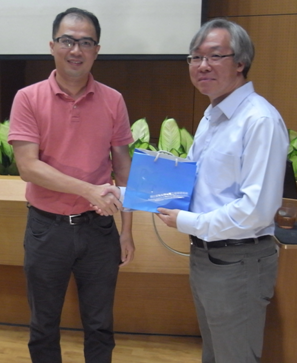 |
|
Dr. Chin-Chieh Chao (right) and Professor Jian-Jang Huang, Vice chairman of GIPO (left) |
|
|
|
4:30 pm, Sept. 30 (Fri.), 2016 |
|
Speaker: |
Professor Tzyy-Sheng Horng (Distinguished Professor, Department of Electrical Engineering, National Sun Yat-Sen University) |
|
Topic: |
From non-inductive to inductive – experience the infinite ingenious uses of electromagnetic waves |
|
Professor Tzyy-Sheng Horng visited GIPO on Sept. 30 (Fri.) and delivered a speech concerning “From non-inductive to inductive
– experience the infinite ingenious uses of electromagnetic waves” at auditorium 101, Barry Lam Hall. His speech was fascinating and the professor interacted well with students. GIPO teachers and students took part in this event with enthusiasm and benefitted a great deal. |
|
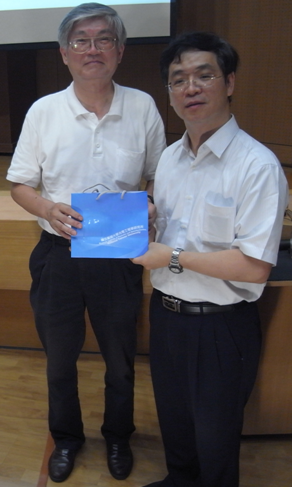 |
|
Professor Tzyy-Sheng Horng (right) and GIPO professor Hung-chun Chang (left) |
|
|
October “GIPO Colloquium” Highlights
(Compiled by Li-Chi Yao) |
|
|
4:30 pm, Oct. 14 (Fri.), 2016 |
|
Speaker: |
Professor Tien-Chang Lu (Department of Photonics, National Chiao Tung University) |
|
Topic: |
Micro/nano-scale lasers based on novel “laser” principle |
|
Professor Tien-Chang Lu visited GIPO on Oct. 14 (Fri.) and delivered a speech concerning “Micro/nano-scale lasers based on novel “laser” principle” at auditorium 101, Barry Lam Hall. His speech was wonderful and informative. The professor also interacted well with students. GIPO teachers and students participated in this event with enthusiasm and learned a great deal. |
|
 |
|
Professor Tien-Chang Lu, the speaker |
|
|
|
4:30 pm, Oct. 21 (Fri.), 2016 |
|
Speaker: |
Professor Chinlon Lin (AT&T Bell Labs and Bellcore (NJ, USA, retired); Honorary Professor, National Chiao Tung University) |
|
Topic: |
Wonders of Light: Impact of Photonics Research on Broadband ICT and Beyond |
|
Professor Chinlon Lin visited GIPO on Oct. 21 (Fri.) and delivered a speech concerning “Wonders of Light: Impact of Photonics Research on Broadband ICT and Beyond” at auditorium 101, Barry Lam Hall. His speech was excellent, and the professor interacted well with students. GIPO teachers and students attended the event with enthusiasm and benefitted greatly. |
|
 |
|
Professor Chinlon Lin (right) and Professor Gong-Ru Lin, Chairman of GIPO (left) |
|
|
November “GIPO Colloquium” Highlights
(Compiled by Li-Chi Yao) |
|
|
4:30 pm, Nov. 4 (Fri.), 2016 |
|
Speaker: |
Professor Pei-Wen Li (Department of Electronics Engineering, National Chiao Tung University) |
|
Topic: |
Back to the Future: Germanium reemerges as the savior of Si opto-electronics |
|
Professor Pei-Wen Li visited GIPO on Nov. 4 (Fri.) and delivered a speech concerning “Back to the Future: Germanium reemerges as the savior of Si opto-electronics” at auditorium 101, Barry Lam Hall. Her speech was wonderfully informative, and the professor interacted very well with students. GIPO teachers and students took part in the event with enthusiasm and benefitted a great deal. |
|
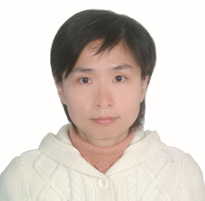 |
|
Professor Pei-Wen Li, the speaker |
|
|
|
4:30 pm, Nov. 18 (Fri.), 2016 |
|
Speaker: |
Professor Tsong-Sheng Lay (Distinguished Professor & Director, Graduate Institute of Optoelectronic Engineering, National Chung Hsing University) |
|
Topic: |
Semiconductor Diode Lasers |
|
Professor Tsong-Sheng Lay visited GIPO, at the invitation of GIPO professor Lung-Han Peng, on Nov. 18 (Fri.) and delivered a speech concerning “Semiconductor Diode Lasers” at auditorium 101, Barry Lam Hall. His speech was splendid, and the professor interacted well with students. GIPO teachers and students took part in the event with enthusiasm and gained a great deal. |
|
 |
|
Professor Tsong-Sheng Lay, the speaker |
|
|
December “GIPO Colloquium” Highlights
(Compiled by Li-Chi Yao) |
|
|
4:20 pm, Dec. 2 (Fri.), 2016 |
|
Speaker: |
Professor Silvano Donati (Emeritus of University of Pavia, IEEE Life Fellow, OSA Emeritus Fellow) |
|
Topic: |
From Order to Chaos and Back: Recent Advances in Optical Cryptography of Transmitted Data |
|
Professor Silvano Donati visited GIPO, at the invitation of GIPO chairman Gong-Ru Lin, on Dec. 2 (Fri.) and delivered a speech concerning “From Order to Chaos and Back: Recent Advances in Optical Cryptography of Transmitted Data” at auditorium 101, Barry Lam Hall. His speech was excellent, rich in contents and the professor interacted well with students. GIPO teachers and students took part in this event with enthusiasm and benefitted a great deal. |
|
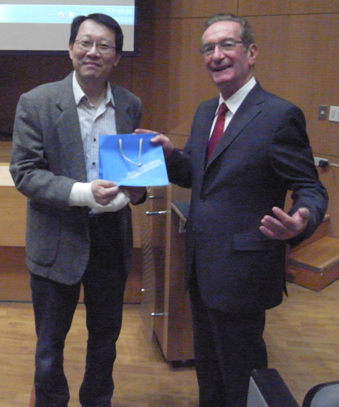 |
|
Professor Silvano Donati (right) and Professor Gong-Ru Lin, Chairman of GIPO
(left) |
|
|
|
10:00 am, Dec. 5 (Mon.), 2016 |
|
Speaker: |
Professor Wei-Chuan Shih (Electrical & Computer Engineering, University of Houston) |
|
Topic: |
3D plasmonic nanoarchitectures for chemical and biosensing |
|
Professor Wei-Chuan Shih visited GIPO on Dec. 5 (Mon.) and delivered a speech concerning “3D plasmonic nanoarchitectures for chemical and biosensing” at auditorium 101, Barry Lam Hall. His speech was informative and the professor interacted very well with students. GIPO teachers and students participated in this event with enthusiasm and gained a great deal from it. |
|
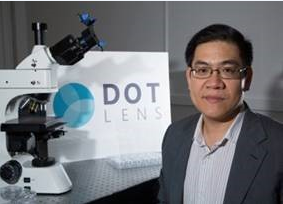 |
|
Professor Wei-Chuan Shih, the speaker |
|
|
|
4:30 pm, Dec. 9 (Fri.), 2016 |
|
Speaker: |
Chief Hsin-Kang Chen (Epistar Corporation) |
|
Topic: |
The application and current trend of laser |
|
Chief Hsin-Kang Chen visited GIPO on Dec. 9 (Fri.) and delivered a speech concerning “The application and current trend of laser” at auditorium 101, Barry Lam Hall. His speech was wonderful and informative, and he interacted perfectly with students. GIPO teachers and students participated in the event with enthusiasm and learned a great deal. |
|
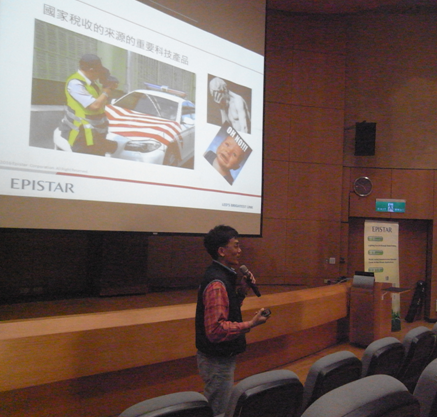 |
|
Chief Hsin-Kang Chen, the speaker |
|
|
~ A self-introduction of the President of GIPO Student Association, 2016
academic year ~
Composed by
Jui-Hsiang Tsai, the president of GIPO Student Association)
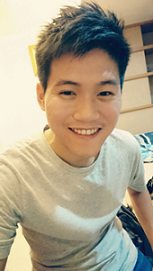 Hi, GIPO teachers, office staff and classmates, I’m
Jui-Hsiang Tsai, the 2016 academic year president of GIPO Student Association. I’m very glad to have this opportunity to be of service to you in this coming year. First of all, I would like to thank Yu-Ting Huang, the former president of the association, for her recommendation which has led me to take this position, and thank GIPO office staff for their help and advice. I hope I can strengthen the association’s works and expand upon the excellent efforts of all former presidents. Hi, GIPO teachers, office staff and classmates, I’m
Jui-Hsiang Tsai, the 2016 academic year president of GIPO Student Association. I’m very glad to have this opportunity to be of service to you in this coming year. First of all, I would like to thank Yu-Ting Huang, the former president of the association, for her recommendation which has led me to take this position, and thank GIPO office staff for their help and advice. I hope I can strengthen the association’s works and expand upon the excellent efforts of all former presidents.
The association is, basically, the students’ representative, and is obliged to strive for students’ interests. On top of that, it is also responsible for holding certain activities in order to create chances for students to get to know each other and improve their friendships. There are two major events each academic year. The first is the 1st semester’s year-end lunch party, which, although there could be minor differences each year, is basically designed, through performances and fine foods, to provide students with a carefree afternoon and leave them with a happy memory from GIPO life. And, the next is the ball game competition held in the 2nd semester, which is certainly an event that exercise-loving students shouldn’t miss. The true purpose of these games is, of course, not to win or to lose, but to enjoy the activity itself. Every detail of the games will be worthwhile for students to appreciate in the future.
During these 2 years in graduate school, most students are immersed in their laboratory studies, and friendships are often limited to among the same laboratory classmates. It is exactly the association’s mission to break this limit, enable students to get to know each other, expand students’ social lives, and eventually improve their relationships with students from different laboratories. I believe everyone should seize every chance to make one’s life more exciting so as not to feel regret in our later years, because obviously we won’t live twice, will we? Whether you are already a well-known student or just an ordinary one, the association welcomes you to join us! Your involvement would expand the GIPO family, and make our graduate institute’s lives not just studies, but a wonderful part of our memories.
The association will, in this coming year, face many challenges. We would welcome your input, which would be good motivation for this association, and we would do our best to attain each goal. For those who are interested in joining us, you are welcome to drop by our laboratory for a chat. I’m the 1st year graduate student in Professor Chih-I Wu’s laboratory. You are also welcome to write to our mailbox should you have questions or suggestions; we will answer your inquiries as soon as we can. For now, we would like to thank GIPO office staff for their help, and thank my instructing professor Chih-I Wu for your support. Finally, I would like to sincerely invite those, new or old students, who are interested in the association to join us. We could do much better with your help.
~ 2016 GIPO Year-end Party ~
(Time: Dec. 28, 2016; Location: 3F courtyard of Ming-Da Hall, EECS, NTU)
Composed by
Jui-Hsiang Tsai, the president of GIPO Student Association
First of all, I would like to thank GIPO officers for their kind help, and thank our association staff for their hard works. After a whole semester of studies, GIPO Student Association held its year-end party and invited everyone to enjoy it with us. This year, aside from the usual delicacies and marvelous performances, there were also funny games and exciting prize-drawings.
|
 |
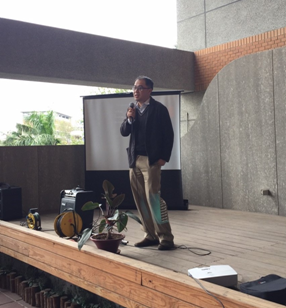 |
|
Shao-Chun Chen (right) & Chi-Wei Wang, the handsome and beautiful host and hostess |
Vice chairman Huang addressing the party |
First, we invited vice chairman Jian-Jang Huang to address the party. Then, we started to devour our gourmet food. This year, we still had Papago to supply us with the food. They’ve worked with us for many years. This time they especially prepared many desserts so as to make the food more colorful. Soft drinks were purchased from Teaplus. We believe both the food and the soft drinks were satisfactory for our guests because everyone ate well.
Regarding the performance, we had only one team performing this year, i.e. me and Yu-Wei
Hsu, a guitar player, played 3 Jay Chou songs. Nevertheless, students seemed very happy to enjoy our performance.
|
 |
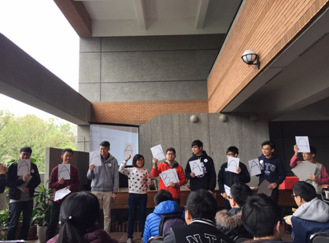 |
|
Performing, Jui-Hsiang Tsai
(left) & Yu-Wei Hsu |
"GIPO Knowledge King" |
|
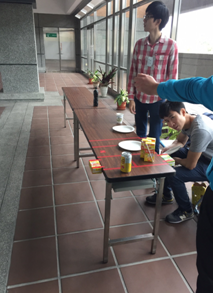 |
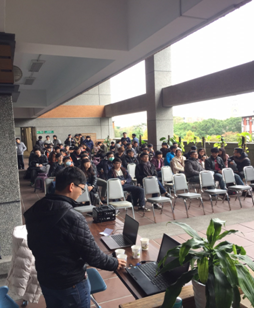 |
|
“Bottle pushing” game |
Audience in front of the stage |
For games this year, we played a small game called “bottle pushing” alongside the courtyard. The game amused many students, and lots of small gifts were given to game players. The “bottle pushing” game added lots of fun to the party. “GIPO Knowledge King” was also a well-liked game; many students participated, and were tested on their academics, general life sense, and even some trivia questions. Participants competed vigorously on the stage, which made watching students laugh constantly. And, the atmosphere on the scene was very joyful.
We were honored to have Professor Jian-Jang Huang and Professor Chao-Hsin Wu draw prizes for us, which has made this program even more thrilling. The 1st prize was an ipad
mini. Other prizes included a Razer keyboard,
a Polaroid, Taobanwu meal vouchers, mobile power supplies, and Audio-Technica earphones. And, the last prizes included lots of Vieshow Cinemas tickets and some small cash gift packs.
|
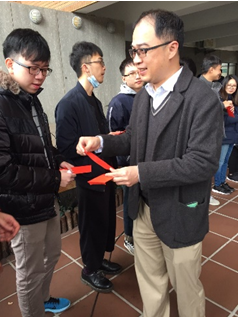 |
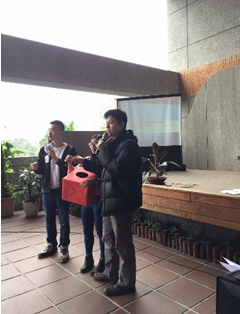 |
|
Professor Jian-Jang Huang handing out prizes |
Professor Chao-Hsin Wu drawing prizes |
GIPO Student Association’s activities for this semester are now at an end. We would like to thank teachers and office staff for their constant help and advice. Thanks also to our association friends for your hard work through the semester. The association’s events would not have been so wonderful without your participation. Thank you to everyone!
|
|
 |
|
 |
|
| |
|
 |
|
~ 2016 Ph.D. Student Academic Exchange with Nanjing University ~
(The 9th Cross-Strait Ph.D. Student Forum on Photonic Science and Technology, 2016)
(Time: Oct. 23 ~
29, 2016; Location: National Taiwan University)
Composed by
Yun-Shiuan Li,
GIPO Ph.D. student
I am honored to have had the opportunity to participate in the 9th Cross-Strait Ph.D. Student Forum on Photonic Science and Technology. This forum has been held for 9 years, sponsored by both GIPO, National Taiwan University, and the School of Physics, Nanjing University. NTU and NJU take turns to hold the forum each year. It has provided an academic and cultural interaction platform for Ph.D. students. This year, it was held by GIPO, at NTU. Therefore, we took part in its preparation, research presentation and discussion, and the cultural portion of the visit. During this one short week, we nourished rational thought, and also enjoyed the humanities, and made many new friends. All this left deep impressions in our minds.
During those 2 days of academic study meetings, there were splendid speeches and abundant discussions. It was always full of enthusiastic interaction and refutation during question times, and attending teachers were more than willing to provide students with suggestions. During intermissions of speeches, people could always be seen surrounding speakers and discussing questions. During the presentation of study results from NJU Ph.D. students, their smooth speeches showed us that they have excellent confidence and speaking abilities. Their enthusiasm towards the meeting and the discussion could also be seen in their cordial studies. This year, the poster exhibition was, for the first time, put into the forum, and exhibited at the art gallery of Barry Lam Hall. In that gallery, before the forum, there were already some pictures and art articles, and when our scientific posters moved in, they looked compatible with those displays. Due to the differences of study fields and the limitation of oral presentation times, the poster exhibition provided us with more channels for interaction. I also took this opportunity to learn about some fundamental research projects from the posters.
The distinguishing characteristic of this forum is that it is completely, from preparation to execution, done by Ph.D. students themselves. Therefore, it indeed provides a chance for students to learn how to hold a forum, i.e. how to plan, prepare and work together and delegate tasks. Besides academic exchanges, the forum still includes lunch and parties, as well as cultural tours. Consequently, we had more opportunities to know NJU students better. Aside from studies, we also shared life experiences with them, and realized some differences between our lives and cultures. After these few days, we realized that NJU Ph.D. students are serious about their studies, but amiable and easy to talk to in private. I remember having had a chat with NJU students at a dinner party. To me, it is interesting to know that aside from studies, they are very concerned about real estate prices. After all, possessing a living space of their own is what they will be striving for after graduation. For us, we tend to be more concerned about future jobs and salaries. These moments allowed us to observe differences in culture and values.
Participating in the 9th Cross-Strait Ph.D. Student Forum on Photonic Science and Technology has not only promoted our knowledge of physics, but also allowed us to observe many aspects of study results, from fundamental research, engineering application to the most advanced technologies. We believe all this has inspired our way of thinking and will certainly do a lot of help in our future research.
|
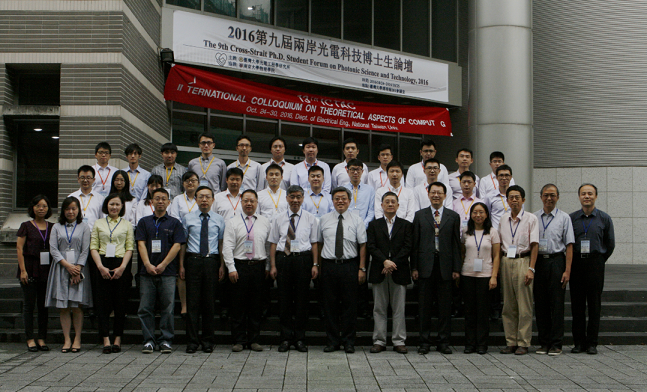
|
|
A group photo of all attendants of the 9th Cross-Strait Ph.D. Student Forum on Photonic Science and Technology |
~ The 9th
International Workshop on Zinc Oxide and Related
Materials;
IWZnO 2016 ~
(Time: Oct. 30 ~ Nov. 2, 2016; Location: Barry Lam Hall, NTU)
Composed by
Fei-Ping Weng
The 9th International Workshop on Zinc Oxide and Related Materials was held at Barry Lam Hall, NTU, from October 30 to November 2, 2016. Member countries take turns holding the biennial workshop; this year, it was hosted by GIPO distinguished professor Chih-Chung Yang. He spent more than half-a-year in preparation for the workshop, from the application of subsidies, the establishment of a website, the invitation of specialized papers, the inviting of reviewers for the international consulting committee, the discussion of preparatory meetings, to helping mainland scholars apply for Taiwan visas, and those individual needs of scholars around the world. Finally, everyone invited arrived in Taiwan and attended the workshop.
In the evening of
October
30, while watching attending scholars arrive from afar to our welcoming party, I realized that it was worthwhile to sponsor such an international workshop, because it elevates Taiwan’s image and provides a platform for exchanges of specialized knowledge. The scholars came from Europe, Asia, North America, South Africa and Australia. According to the number of presented papers of individual countries, they were, from high to low, Mainland China, Taiwan, Japan, Poland, Norway, Korea, Germany, USA, France, Australia, Singapore, Spain, Czech, India, Latvia, Lithuania, Russia, South Africa, and UK. There were 168 papers altogether, including 60 oral presentations and 108 poster exhibitions, which revealed that the attending scholars had been working very hard in the field of
Zinc Oxide and related materials. There were altogether 188 scholars attended, including 124 foreigners and 64 locals.
Aside from paper presentations, we also hosted an evening banquet at the historic Grand Hotel. During this banquet, a small-scale Chinese orchestra played some oriental tunes and several pieces of world-famous music, which, we believed, could bring science and arts into harmony. When scholars from other countries heard familiar melodies, or folk music from their own countries’, they would sing along or beat time to the music. Such an atmosphere looked peaceful and pleasant.
There was an outing to Yangmingshan National Park scheduled on the last half-day. However when we checked the spot and found that some areas of the park were under construction, we rearranged our schedule. On that day, when the bus drove through Taipei’s streets, Professor Yang personally explained Taipei’s buildings and their history to the scholars on-board. When we were at Hsiao-Yo-Kearn, it was raining and blowing, but our guests had all brought jackets and umbrellas or raincoats with them because we had already reminded them twice before departing. We were more than happy to appreciate natural changes in the mountain and forest climate, and therefore enjoyed everything nature provided. Fortunately, when we arrived at Yehliu Geopark, it was cool and dry, and everyone enjoyed exploring the park. We also did our best to return our guests directly to their hotels from the outing, and from the evening banquet.
Through this workshop, foreign scholars who came to Taiwan for the first time can understand further the hard work Taiwan scholars have done in the research of Zinc Oxide, and, of course, they can know Taiwan better.
Besides Professor Chih-Chung Yang’s preparation and leadership, the success of this 9th International Workshop on Zinc Oxide and Related Materials is owed in part to the US Navy Laboratory, the ROC Ministry of Science and Technology, the Bureau of Foreign Trade (Ministry of Economic Affairs, ROC), and the Department of Information and Tourism (Taipei city government). We would also like to thank NTU for their subsidy, and thank Professor Jian-Jang Huang, Professor I-Chun Cheng and Professor Chao-Hsin Wu for their help in leading each bus. Thanks also to those who were helping in the workshop for your cooperation and hard work. Thank you to those students who came to help and receive guests. And thank you to the photographers who had helped take pictures. Many grains of sand piled up will make a pagoda; therefore, each one’s endeavor becomes an important part of an event. Your hard work was the reason the workshop proceeded so successfully.
|
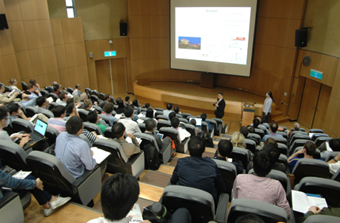 |
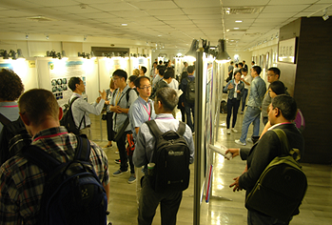 |
|
Oral presentation |
Poster exhibition |
|
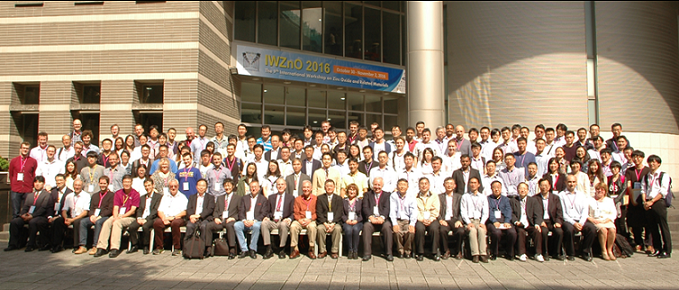
|
|
A group photo of all attendants |
|
|
 |
|
 |
|
| |
|
 |
Multi-resonant optical parametric oscillator based on 2D-PPLT nonlinear photonic crystal
Professor Lung-Han Peng
Graduate Institute of Photonics and
Optoelectronics, National Taiwan
University
In a recent collaborative work of Prof. Lung-Han PENG with Prof. Azzedine BOUDRIOUA (Galilee Institute, U. Paris 13, France) via Dr. Lazoul, and Prof. Simohamed of Ecole Militaire Polytechnique (Algeria), the authors made a report on Optic Letters regarding a multi-resonant optical parametric oscillator based on 2D nonlinear photonic crystals (NPC) periodically poled lithium tantalate (PPLT). This work takes advantage of the abundant multi-reciprocal lattice vectors uniquely prevailed in 2D-PPLT (developed at NTU) such that simultaneous multi-wavelength optical parametric oscillations (OPO) can take place. In comparison, for the conventional 1D case, wavelength tuning of OPO has to be taken by sequentially changed the grating vectors of the transversely-displaced quasi-phase-matching structures of the NPC, or by angle- or temperature-tuning of a single-QPM grating NPC. Figure 1 illustrated the experimental setup performed at the Laboratory of Laser Physics, Galilee Institute of U. Paris 13, and Fig.2 demonstrated multi-wavelength coverage when the incident power of a 532nm green pump laser is (a) below the oscillation threshold for optical parametric generation (b) near the oscillation threshold, and (c) 1.5 times of the oscillation threshold.
Ref: Mohamed Lazoul, Azzedine Boudrioua, Lotfy-Mokhtar Simohamed, and Lung-Han Peng, “Multi-resonant optical parametric oscillator based on 2D-PPLT nonlinear photonic crystal,” Opt.
Lett.
40,
1861 (2015).
Laser-diode pumped glass-clad Ti:sapphire crystal fiber laser
Professor Sheng-Lung Huang’s laboratory
Graduate Institute of Photonics and
Optoelectronics, National Taiwan
University
Titanium (Ti):sapphire crystals have become one of the most widely used solid-state laser gain media. Their broadband emission spectra are suitable for a wide range of applications, such as tunable lasers and mode-locked lasers, although their low absorption cross section and short lifetime prevent them from low threshold operations. In this work, efficient glass-clad crystal fiber lasers were demonstrated using a Ti:sapphire crystalline core as the gain medium. With a core diameter of 18 μm, the laser diode (LD) pump source can be effectively coupled and guided throughout the crystal fiber for a low threshold and high slope efficiency laser operation. The advantage of high heat dissipation efficiency of the fiber structure can be derived from the low core temperature rising measurement (i.e. 17 K/W) with passive cooling. At an output transmittance of 23%, the lowest absorbed threshold of 118.2 mW and highest slope efficiency of 29.6% were achieved, with linear laser polarization.
|

|
|
Fig. 1. SEM images of (a) end face of a glass-clad Ti:sapphire crystal fiber and (b) side face of a Ti:sapphire crystalline core; TEM images of (c) crystalline sapphire core and (d) interface of core and borosilicate clad. Dashes outline the 2-nm overlapping layer. |
|
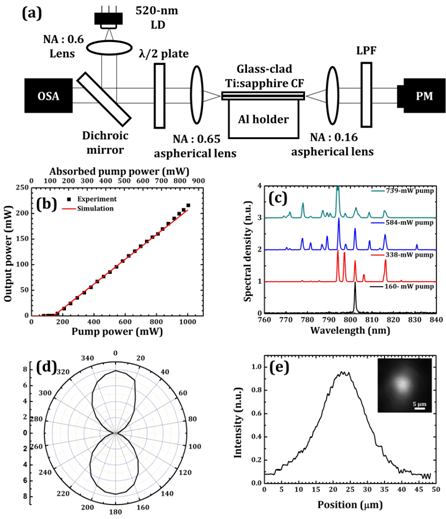
|
|
Fig. 2. (a) 520-nm LD pumped glass-clad Ti:sapphire crystal fiber laser scheme, (b) L-I curve by 520-nm LD pumping, (c) lasing spectra at different pump powers, (d) laser polarization measurement, and (e) lasing transverse mode profile. LPF: long wavelength pass filter; the red line in (b) is the simulation result. PM: power meter; OSA: optical spectrum analyzer. |
Reference:
S. C. Wang, C. Y. Hsu, T. T. Yang, D. Y. Jheng, T. I Yang, T. S. Ho, and S. L. Huang, “Laser-diode pumped glass-clad Ti:sapphire
crystal fiber laser,” Optics Letters,
41,
pp. 3217–3220, 2016.
Noninvasive third harmonic generation microscopy reveals the dietary evolution in the ultrastructure of dinosaur teeth
Professor Chi-Kuang Sun
Graduate Institute of Photonics and
Optoelectronics, National Taiwan
University
Fossilized teeth are primary tools in the study of vertebrate evolution, but standard imaging modalities have not been able to provide high-quality image contrast and 3D information inside dentin, the main component of teeth, owing to small refractive index differences in the fossilized tissues. Our first attempt to use third harmonic generation (THG) microscopy in numerous fossil teeth, spanning 300 Ma of vertebrate history, has yielded significant submicron level anatomy, with an unexpectedly strong THG signal contrasting fossilized tubules from the surrounding dentin. Morphometric analyses of dentinal tubule diameter, density, and branching rates provide strong phylogenetic signatures and reveal patterns consistent with evolutionary relationships among various groups of amniotes, including dinosaurs. These morphometric analyses reveal a strong signal for dietary preferences, with herbivorous saurischian and ornithischian dinosaurs consistently having higher dentinal tubule density than their carnivorous relatives. We hypothesize that this relates to the hardness of the dentine, where herbivorous taxa have dentine that is more resistant to breakage and wear at the dentine-enamel junction than carnivorous taxa. Our results also represent the only successful imaging of dentinal tubules in fossilized tissues while maintaining a sub-micron resolution, providing non-invasive 3D histological reconstruction in intact fossil teeth, demonstrating the great potential of our developed harmonic generation microscopy for the evolutionary studies of vertebrates. This work is in collaboration with Robert R. Reisz, University of Toronto Mississauga, Canada, Dar-Bin Shieh, National Cheng Kung University, and Timothy D. Huang, a dinosaur lover.
|
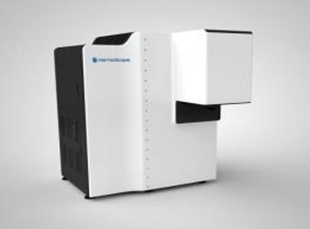
|
|
Figure 1: One of the Harmonic Generation Microscopes (HGM) built and designed in Prof. Sun’s laboratory. HGM was designed for noninvasive clinical microscopy imaging on human skin and mucosa, while with a world-record performance on resolution, penetration depth, and bio-viability. Its operating wavelength is at 1260 nm, and can penetrate even the darkest skin. Obviously it is also perfect for fossil studies. |
|
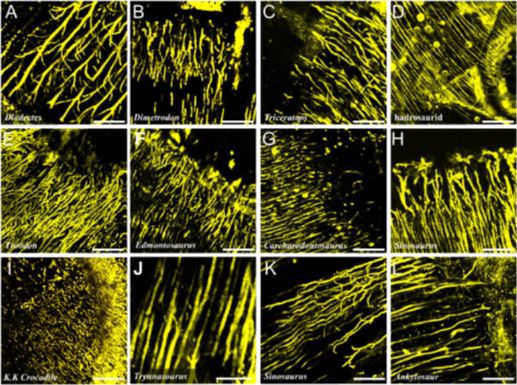
|
|
Figure 2: Optically-sectioned 2D third-harmonic-generation microscopic images of the dentine-enamel junction from various fossil teeth. All scale bars, 20 μm. For animal’s outlook and their ages, please refer to Figure 3 and Figure 4. For 3D images, please refer to our references. |
|
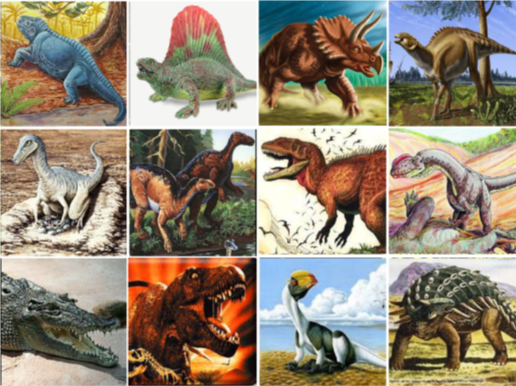
|
|
Figure 3: The imagination reconstruction of the ancient vertebrates where our fossil teeth came from. One to one correspondence on the relative position with respect to Figure 2 can be found. We appreciate all the sources where the pictures are from. |
|
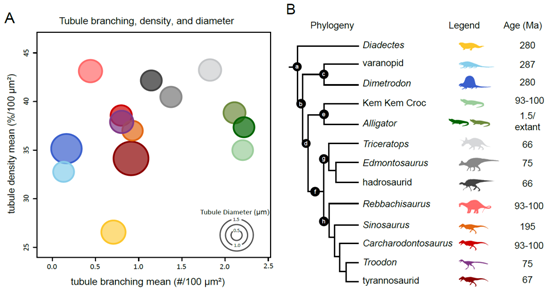 |
|
Figure 4: Results of morphometric analysis of dentinal tubules. (A) Bivariate plot of dentinal tubule density mean, tubule branching mean, and diameter. The sizes of the colored circles are representative of tubule diameter. The colors of the circles match the taxa in the phylogeny (B), which contains all taxa examined in this study. a, Cotylosauria; b, Amniota; c, Synapsida; d, Archosauria; e, Crocodylia; f, Dinosauria; g, Ornithischia; h, Saurischia. Abbreviation: Ma, Millions of years. |
Reference:
Y.-C. Chen, S.-Y. Lee, Y. Wu, D.-B. Shieh, K. Brink, T. D. Huang, R. R. Reisz,
and C.-K. Sun, “Third harmonic generation
microscopy reveals dental anatomy in ancient
fossils,”
Optics Letters
40
(7), pp. 1354-1357 (2015).
K. S. Brink, Y.-C. Chen, Y.-N. Wu, W.-M. Liu, D.-B. Shieh, T. D. Huang, C.-K. Sun, and R. R. Reisz, “Dietary adaptions in the ultrastructure of dinosaur dentine,” to appear in Journal of the Royal Society Interface.
Localized surface plasmon-enhanced photoluminescence of amorphous silicon quantum dots through plasmonic subwavelength crossed metallic gratings
Professor Hoang-Yan Lin
Graduate Institute of Photonics and
Optoelectronics, National Taiwan University
We investigate experimentally the enhancing effect of plasmonic subwavelength crossed Ag gratings on photoluminescence (PL) from the amorphous silicon quantum dots (a-Si QDs) embedded in a central silicon-rich SiOx film of the Ag/SiOx:a-Si QDs/Ag sandwich nanostructures (Fig. 1). The use of the crossed Ag grating structure as the top layer in the sandwich nanostructures results in a 2-fold increase in the PL peak intensity and a 1.34-fold increase in the integrated emission intensity compared with the use of a one-dimensional (1D) Ag grating top layer, and a 1.53-fold peak intensity increase compared with that of a SiOx:a-Si QDs/Ag structure without a Ag top layer (Fig. 2). These significant PL enhancements can be attributed to the high light-extraction efficiency of the polarization-independent crossed metallic grating structure, the strong out-coupling of localized surface plasmons (LSPs), and the strong a-Si QD–LSP coupling. (Japanese Journal of Applied Physics 55, 04EH15 (2016))
|

|
|
Fig. 1. Schematic structures of the trilayer Ag=SiOx:a-Si QDs=Ag sandwich nanostructures on a Si substrate with (a) 1D Ag grating and (b) symmetric crossed Ag grating on the top. |
|
 |
|
Fig. 2. (a) PL spectra of the sample without Ag top layer, and the planar Ag thin film, 1D Ag grating, and crossed Ag grating MIM samples. (b) Polarization-dependent PL spectra of the 1D and crossed Ag grating samples. |
Laser Diode LiFi and MMW-Over-Fiber Link
Professor Gong-Ru Lin’s Laboratory
Graduate Institute of Photonics and
Optoelectronics, National Taiwan
University
Phosphorous Diffuser Diverged Blue Laser Diode for Indoor Lighting and Communication
A phosphorous diffuser diverged blue GaN laser diode (LD) is successfully demonstrated for both indoor luminescent white-lighting and optical wireless communication over a 60-cm free-space link, which represents a current state-of-the-art performance for carrying orthogonal frequency-division multiplexed 16-quadratureamplitude modulation (16-QAM OFDM) data at 5.2 Gbit/s, as illustrated in Fig. 1. As a result, the luminescent phosphor doped diffuser diverges the blue laser beam to a white-light spot covering a radiant angle of 120 degree with CIE coordinates of (0.34, 0.37), as shown in Fig. 2. As displayed in Fig. 3, the phosphorous diffuser diverged luminescent light spot exhibits its ability to carry the 5.2-Gbit/s 16-QAM OFDM data with an error vector magnitude of 17.3%, a signal-to-noise ratio (SNR) of 15.3 dB and a bit error rate (BER) of 3.6×10−3.
|
 |
|
Fig. 1 The blue LD with phosphorous diffuser for luminescent white-lighting and optical wireless OFDM communication over a 60-cm free-space link. |
|
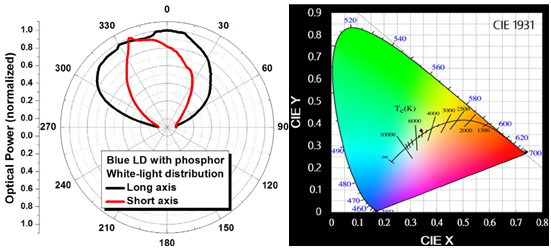 |
|
Fig. 2 The light distribution in polar coordinate and the chromaticity coordinates result. |
|
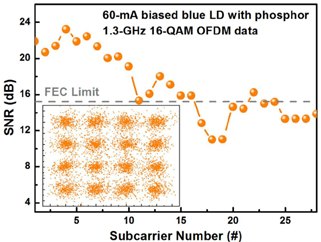 |
|
Fig. 3 The subcarrier SNRs and related constellation plot of the 5.2-Gbit/s 16-QAM OFDM data. |
60-GHz Millimeter-wave Over Fiber with Directly Modulated Dual-mode Laser Diode
A directly modulated dual-mode LD (DMLD) with third-order intermodulation distortion (IMD3) suppression is proposed for a 60-GHz millimeter-wave over fiber (MMWoF) architecture, enabling new fiber-wireless communication access to cover 4-km single-mode-fiber (SMF) and 3-m wireless 16-QAM OFDM transmissions, as depicted in Fig. 4. By dual-mode injection-locking, the DMLD mitigates its throughput degradation with saturation effect to reduce the threshold, IMD3 power and relative intensity noise to 7.7 mA, −85 dBm and −110.4 dBc/Hz, respectively. After 4-km SMF and 3-m free space transmissions, the optical receiving power is optimized to restrict the power fading effect for improving the BER to 1.9×10−3 and the receiving power penalty to 1.1 dB, as shown in Fig. 5. Such DMLD based hybrid architecture for 60-GHz MMW fiber-wireless access can directly cover the current optical and wireless networks for next-generation indoor and short-reach mobile communications.
|
 |
|
Fig. 4 The DMLD based hybrid architecture for 60-GHz MMW fiber-wireless access can cover the current optical and wireless networks for indoor communications. |
|
 |
|
Fig. 5 (Left) The schematic diagram for 60-GHz wireless access architecture. (Right) The BER response and constellation plots of the DMLD carried 16-QAM OFDM data after SMF and 3-m free space transmissions. |
|
|
|
 |
|
 |
|
| |
|
|
 |
|
 |
|
|
|